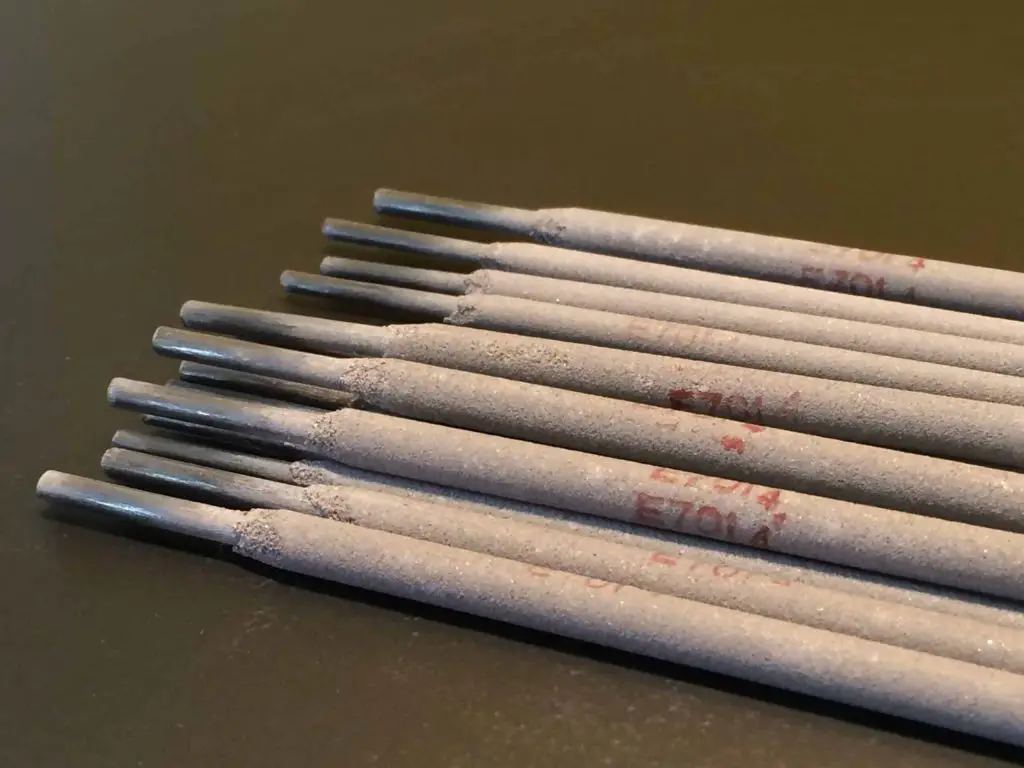Arc welding is one of the most common welding techniques you can use to combine two metals. Arc welding uses a welding machine which creates an electric arc that melts metal. To create an arc, you need an electrode that will spark the arc between your machine and the base metal. Two of the most common electrodes are 7014 and 7018 welding rods.
7014 and 7018 welding rods are very similar. They have the same tensile strength, positioning, arc characteristics, and drag motion. However, they differ in terms of material composition, durability, and usability. That in turn affects how you can use them.
Here is a guide to help you tell the difference between these two welding rods.

Table of Contents
What Is a 7014 Welding Rod Used For?
7014 welding rods are extremely versatile and useful in many applications. These welding rods are made of iron powder and titania coating. The coating makes them resistant to moisture and damp, making the 7014 welding rod perfect for outdoor uses or dirty jobs.
7014 welding rods are tough but delicate tools. They have a medium penetration, making them ideal for thinner materials such as sheet metal. Rugged on the one hand, delicate on the other, the 7014 welding rods are masters of contradiction indeed. Some of the industries that use 7014 welding rods include:
- Farming
- Automotive parts
- Outdoor structural welding
- Welding art
With such a wide range of applications, having a few 7014 electrodes in your welding kit is a good idea.
When Can’t You Use a 7014 Welding Rod?
However, there are a few situations when you can’t use your trusty 7014 welding electrodes.
One is if you are working with steel. Steel works better with welding rods of similar materials. Since 7014 welding electrodes are made of iron, they don’t work well with steel. Instead, use your 7014 electrodes when you’re working with other materials such as iron alloys.
7014 electrodes are also not ideal for vertical welding. Although the “1” in the name indicates that these electrodes work in all positions, it is a lot harder to weld with them in vertical positioning. That is one reason why many professional welders that have to clamber up machinery don’t always use these electrodes.
Finally, 7014 electrodes are not always useful in professional applications because they don’t offer full penetration. When working with extremely thick material, you want a sturdier weld than these electrodes can provide.
What Is a 7018 Welding Rod Used For?
7018 welding rods are slightly different from 7014 welding rods. The biggest difference is in their material composition and flux coating. 7018 welding rods have an iron powder low hydrogen coating instead of a titania coating.
The different coating means that 7018 welding rods have vastly different properties compared to 7014 welding rods. They have fast freezing properties, making them better for work at various angles (although you still shouldn’t use them vertically). They have a much deeper penetration than 7014 welding rods. They are also better for working with high carbon steel because the material in their coating binds well with the material in the steel.
7018 welding rods are actually very popular in industrial usage. You’ll find them in many places including:
- Structural steel work
- Complex construction projects such as energy power plants
- Bridge engineering
When Can’t You Use a 7018 Welding Rod?
7018 welding rods are very powerful and tough. You might be wondering why welders don’t use them everywhere if they create such a strong weld. However, there are a few ways these welding rods fall short.
Although they are tough in terms of penetration and joint strength, 7018 electrodes are very fragile when it comes to environmental influences. You have to store them in precise ways, protecting them from any moisture, otherwise they won’t work properly. That means any outdoor work, such as on farm equipment, is hard with these welding rods.
7018 welding rods are also notoriously difficult for beginners to use. They are much harder to control and get a smooth weld, so amateurs should steer clear of them until they have a better grasp of their craft.
Different Properties of the 7014 and 7018 Rods
Now that you understand the different materials and usage conditions of these two welding rods, let’s compare their properties including:
- Polarity
- Tensile strength
- Penetration
Polarity Differences
7014 electrodes work with all currents, including AC, DC-, and DC+. 7018 electrodes work with almost all currents but are not compatible with DC-.
Tensile Strength Differences
7014 and 7018 rods actually have the same tensile strength. They have a maximum tensile strength of 70,000 psi. Tensile strength measures how resistant a material is to breaking or cracking under pressure and it is measured in pounds per square inch.
You can tell the tensile strength of any welding rod by looking at the first two digits of its numerical name. This stands for the tensile strength in tens of thousands of psi.
Penetration Differences
Both 7014 and 7018 electrodes are technically classified as medium penetration electrodes. However, 7018 electrodes achieve slightly deeper results when working with DC. That is thanks to the fast freezing properties of 7018 electrodes, which also make it easier to work in atypical positioning.
Final Thoughts
7014 and 7018 electrodes have similar names, but they are actually fairly different electrodes. Although their tensile strength is the same, their polarity and penetration differs slightly. They have a different material, with the former having a titania flux coating and the latter using a low hydrogen coating.
The material affects their usefulness. 7018 electrodes are better for working with high carbon steel, even in unwieldy positions, which is why they are often used in heavy industry and construction, even for big projects such as power plants. However, 7014 electrodes are much easier to use and better suited for working outdoors or in damp conditions, which is why they are more popular for DIY.


